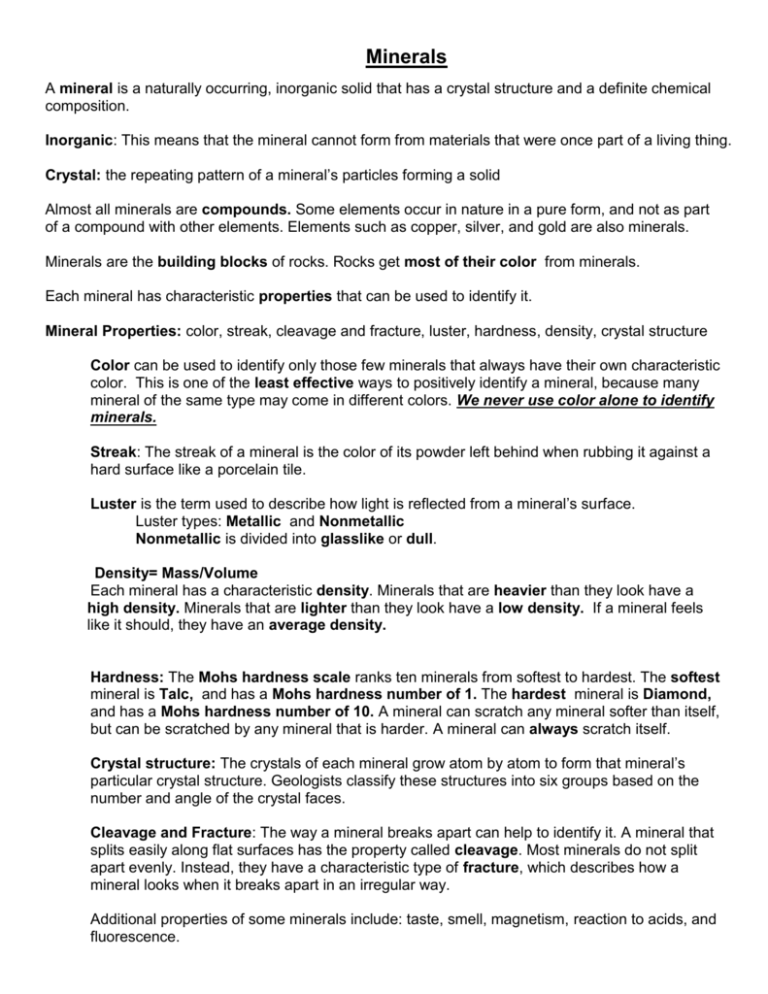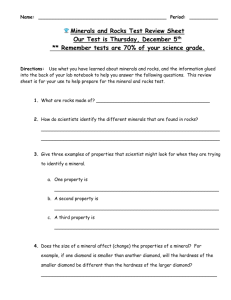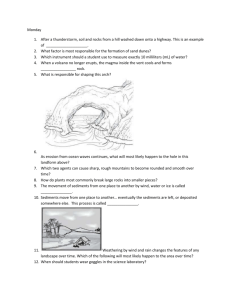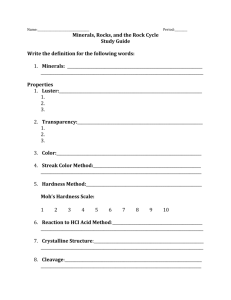Rocks, minerals, earth layers supplemental note sheet
advertisement

Minerals A mineral is a naturally occurring, inorganic solid that has a crystal structure and a definite chemical composition. Inorganic: This means that the mineral cannot form from materials that were once part of a living thing. Crystal: the repeating pattern of a mineral’s particles forming a solid Almost all minerals are compounds. Some elements occur in nature in a pure form, and not as part of a compound with other elements. Elements such as copper, silver, and gold are also minerals. Minerals are the building blocks of rocks. Rocks get most of their color from minerals. Each mineral has characteristic properties that can be used to identify it. Mineral Properties: color, streak, cleavage and fracture, luster, hardness, density, crystal structure Color can be used to identify only those few minerals that always have their own characteristic color. This is one of the least effective ways to positively identify a mineral, because many mineral of the same type may come in different colors. We never use color alone to identify minerals. Streak: The streak of a mineral is the color of its powder left behind when rubbing it against a hard surface like a porcelain tile. Luster is the term used to describe how light is reflected from a mineral’s surface. Luster types: Metallic and Nonmetallic Nonmetallic is divided into glasslike or dull. Density= Mass/Volume Each mineral has a characteristic density. Minerals that are heavier than they look have a high density. Minerals that are lighter than they look have a low density. If a mineral feels like it should, they have an average density. Hardness: The Mohs hardness scale ranks ten minerals from softest to hardest. The softest mineral is Talc, and has a Mohs hardness number of 1. The hardest mineral is Diamond, and has a Mohs hardness number of 10. A mineral can scratch any mineral softer than itself, but can be scratched by any mineral that is harder. A mineral can always scratch itself. Crystal structure: The crystals of each mineral grow atom by atom to form that mineral’s particular crystal structure. Geologists classify these structures into six groups based on the number and angle of the crystal faces. Cleavage and Fracture: The way a mineral breaks apart can help to identify it. A mineral that splits easily along flat surfaces has the property called cleavage. Most minerals do not split apart evenly. Instead, they have a characteristic type of fracture, which describes how a mineral looks when it breaks apart in an irregular way. Additional properties of some minerals include: taste, smell, magnetism, reaction to acids, and fluorescence. Rocks Rocks are a mixture of 1 or more minerals, and other substances such as volcanic glass, or organic material. The 3 classifications of rock are igneous, sedimentary, and metamorphic rock. Rocks are classified by how they are formed. The Rock Cycle is a model that shows how one classification of rock can change into another. Igneous Rocks Igneous rocks are formed by the cooling of magma or lava. 2 types are intrusive and extrusive: Intrusive: Formed from magma cooling INSIDE the earth. Extrusive: Formed from lava cooling OUTSIDE on the earth’s surface. Rocks that cool slowly have larger crystals or grains Silica is a material formed from oxygen and silicon. This compound creates silicate minerals. Igneous rocks formed from magma/lava with LOW silica content are usually dark colored rocks such as basalt. Igneous rocks formed from magma/lava with a HIGH silica content are usually light colored rocks such as granite. Sedimentary Rock Most sedimentary rocks are formed from the compaction and cementation of sediments. Most sedimentary rocks display layers. Sediments are small fragments (broken pieces) of materials that can come from rocks, shells, bones, or other living things. 3 types of sedimentary rock: clastic, organic, and chemical sedimentary rock. Clastic-made of rock pieces pressed and glued together (compaction/cementation). Steps of Clastic Sedimentary Rock Formation Weathering of rock- becomes sediments- sediments undergoes erosion-sediments are deposited (deposition)- compaction takes place-cementation takes place-sedimentary rock is born. Weathering: breaking down of rock Erosion: movement of rock by wind, water, gravity, and glaciers Compaction: sediments are compressed (squeezed together) by the weight of the layers above Cementation: dissolved minerals recrystallize and glue sediments together Organic- made by the remains of once living things. Chemical- Made from dissolved minerals that recrystallize. Fossils will only be found in sedimentary rocks. Metamorphic Rock Formed by any rock exposed to extreme heat and pressure. 2 types of metamorphic rocks: foliated, and non-foliated. Foliated rocks have grains arranged in parallel bands or stripes; can sometimes flake or peel apart. Non-foliated do not have bands or stripes. Pressure, Density, and Temperature: All increase as we go deeper into the Earth . Earth Layers- Four main layers; Crust, Mantle, Outer Core, Inner Core Crust- Thinnest layer. This layer is the outermost part of the earth. In comparison to the other layers, it is like an egg shell of a hard boiled egg compared to the rest of the egg. Has both Continental and Oceanic Crust. Continental crust is granitic (made mostly of granite), and oceanic crust is basaltic (made mostly of basalt). This Layer is the coolest, but can get to 860 degrees Celsius and has the lowest density(2.7-3.0 g/cm3) and pressure. Mantle- Thickest layer when combining upper and lower. About 2900km. Made of molten rock(magma). This Layer is very hot, and has a higher density and pressure than the crust. Outer Core- Almost as thick as the entire mantle. Made of liquid iron and nickel. Causes Earth’s magnetic field. This Layer is hotter, and has a higher density and pressure than the mantle. Inner Core- This layer is at the Center of the Earth. Medium Thickness. Made of Solid Iron and nickel. This Layer is the hottest and has the highest density and pressure.







